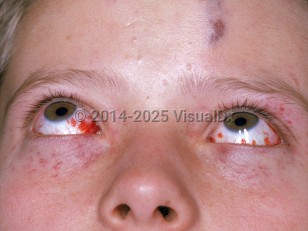While cases of bacterial meningitis have decreased over the past several decades as a result of use of Haemophilus influenzae type b conjugate vaccine and polysaccharide pneumococcal vaccine, contemporary studies suggest the incidence is 4-6 cases per 100 000 adults and as high as 80 cases per 100 000 infants aged younger than 2 months. The 3 most common pathogens, H influenzae, Neisseria meningitidis, and Streptococcus pneumoniae, account for > 80% of cases in the adult population. Group B Streptococcus (GBS) accounts for the majority of infections in infants aged younger than 2 months. Mortality is higher for pneumococcal meningitis (as high as 30%) versus non-pneumococcal meningitis (7%-11%).
In developing countries with a high prevalence of pulmonary tuberculosis, Mycobacterium tuberculosis is a common cause of meningitis. Tuberculosis of the arachnoid space is a complication of tuberculous meningitis.
Antecedent history of otitis media, upper respiratory tract infection, pneumonia, gastrointestinal symptoms, or trauma may provide an indication to possible etiologic agents.
Neisseria meningitidis can cause characteristic skin manifestations such as petechiae and palpable purpura.
Patients with Listeria meningitis have an increased risk of seizures and focal neurological deficits early in the course of infection. Rhombencephalitis can occur, manifested as ataxia with cranial nerve palsies and/or nystagmus. Consumption of undercooked or improperly refrigerated food has been linked to sporadic Listeria outbreaks.
Acute bacterial meningitis may manifest as meningitis or meningoencephalitis with or without accompanying sepsis. The classic triad of acute meningitis includes fever, neck stiffness, and altered mental status. These 3 findings at presentation are found in only 44% of patients. However, at least 2 of 4 findings of headache, fever, stiff neck, and altered mentation are seen in 95% of patients. Altered mental status is present in almost two-thirds of patients with bacterial meningitis and is usually absent in viral meningitis unless coincident encephalitis is present. Lethargy or altered level of consciousness is more common in acute bacterial meningitis, with coma seen in up to 20% of patients. Depression of sensorium occurs more commonly with pneumococcal rather than meningococcal meningitis.
Focal cerebral abnormalities to consider include hemiparesis, monoparesis, and aphasia and may be due to stroke, seizures, or both. Cranial nerve palsies may occur, with eighth nerve palsy being most common.
The 3 clinical features on presentation that portend an adverse outcome appear to be the presence of hypotension, altered mental status, and seizures.
Rarely, meningitis may persist for 4 weeks and is then considered chronic meningitis.
Common acute meningitis bacterial pathogens by risk factor:
Age younger than 1 month:
- GBS
- Escherichia coli
- Listeria monocytogenes
- Klebsiella spp.
- Streptococcus pneumoniae
- Neisseria meningitidis
- GBS
- Haemophilus influenzae
- Escherichia coli
- Neisseria meningitidis
- Streptococcus pneumoniae
- Streptococcus pneumoniae
- Neisseria meningitides
- Listeria monocytogenes
- Aerobic gram-negative bacilli
- Streptococcus pneumoniae
- Haemophilus influenzae
- Group A beta-hemolytic streptococci
- Staphylococcus aureus
- Coagulase-negative staphylococci
- Aerobic gram-negative bacilli (including Pseudomonas aeruginosa)
- Aerobic gram-negative bacilli (including P aeruginosa)
- Staphylococcus aureus
- Coagulase-negative staphylococci
- Coagulase-negative staphylococci
- Staphylococcus aureus
- Aerobic gram-negative bacilli (including P aeruginosa)
- Cutibacterium acnes (formerly known as Propionibacterium acnes)
- Streptococcus pneumoniae
- Neisseria meningitides
- Listeria monocytogenes
- Aerobic gram-negative bacilli



